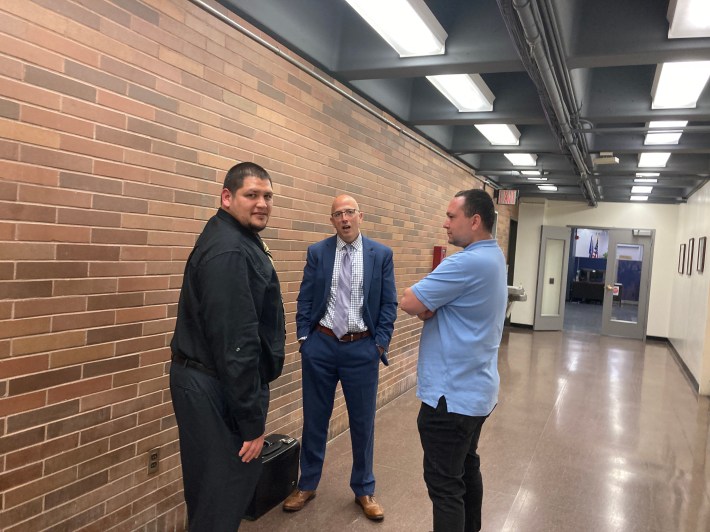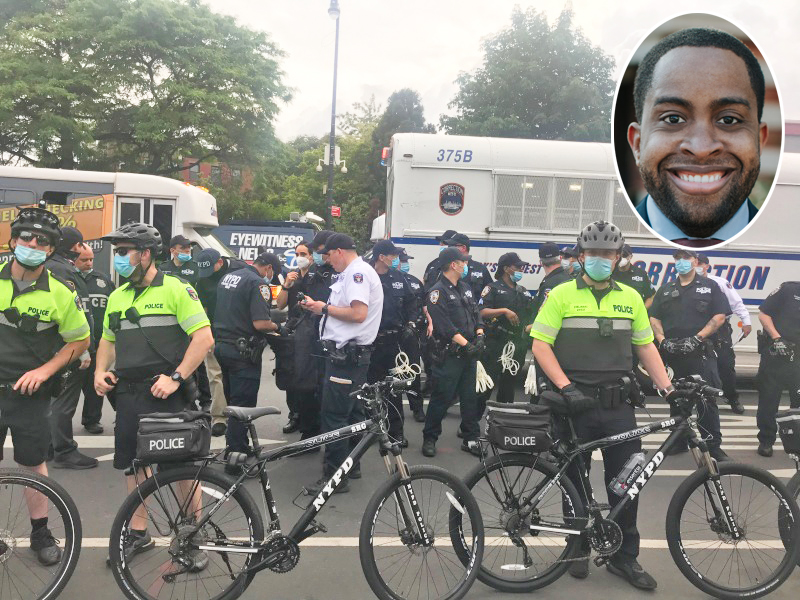Police on Wednesday justified cops’ excessive use of force against a Brooklyn state pol saying he was blocking traffic and refused to clear the roadway during a protest outside the Barclays Center after the murder of George Floyd two years ago.
But the lawmaker, state Sen. Zellnor Myrie of Brooklyn, testified at a departmental disciplinary hearing that the officer in question used excessive force with department-issued bikes, and threatened him with pepper spray in a display of force that shocked him and traumatizes him to this day.
“I felt what felt like bike tires on my back and on my arms and I was incredibly confused as to why there was any force being used when I was walking away and trying to comply,” Myrie said during tearful testimony in the in-house trial of Officer Michael Kovalik, a member of the NYPD’s Strategic Response Group. “And at some point I recall seeing an officer with a canister and recall pepper spray leaving the canister, and excruciating pain, and fear of what could come next.”
Video footage shared during the hearing confirmed that cops from the SRG — once dubbed “the goon squad” because of its aggressive conduct — also shoved their metal bike frames into then-Assembly Member Diana Richardson, who is seen on tape toppling to the ground. Myrie is seen attempting to protect his colleague before officers detained him with zip ties. The two pols have also filed a separate federal lawsuit against the NYPD in relation to that incident.
A Civilian Complaint Review Board investigation returned a finding that Kovalik abused his authority for threatening individuals, and specifically Myrie (D-Flatbush), with a can of pepper spray during a protest on May 29, 2020.
Kovalik's lawyer argued that nothing untoward happened that night.
“The peaceful protest got out of hand, and while it may not have turned into a riot, it certainly turned into other unlawful behavior," said the lawyer, Michael Martinez. “The problem is they were breaking the law ... as they stood in the middle of the street on Flatbush Avenue, at some point, several hundred of them, they shut down the entire intersection. You're not allowed to do that. There are times you can close off streets with permits and Sen. Myrie definitely knows that, but you're not allowed to spontaneously close down a major artery of the city. There are numerous reasons for that.”
The allegations against Kovalik are just some of the many levied against members of the NYPD from the protests two years ago, including the brutal and violent use of department-issued bicycles — another example of the alleged excessive use of force they used that night against Myrie and Richardson (D-Crown Heights).
Kovalik — who has one other allegation against him from 2013 that’s been substantiated, according to records of police misconduct — was not the officer who actually sprayed the mace in the pol's eyes. But those members of the NYPD have either not been charged, or have not been identified. Myrie was ultimately released shortly after he was cuffed.

At the center of the trial is whether Kovalik threatened Myrie with the canister of pepper spray by swinging it around his head. Myrie's attorney, CCRB prosecutor Andre Applewhite says it's clear, after reviewing dozens of videos from officers’ body-worn cameras, that he did.
“While [Myrie] was complying, the respondent pointed his pepper spray can in the face of Senator Myrie and in the direction of individuals,” said Applewhite.
Yet Martinez continued to argue that Myrie's location is a central part of why Kovalik acted as he did.
“The police department was extremely patient. [The protesters] are not on the sidewalk, which is where the NYPD requires you to be during protests, and not shutting down major arteries there in the middle of the street,” he said. “You know what the sidewalk is and you know what the street is. The street is where vehicles go, the sidewalk is where the pedestrians go.”
And Martinez claimed that Myrie instigated police aggression by putting his hands in the air rather than just walking away. Myrie said he did that as a means of survival, for both himself and Richardson.
“I was trying to protect the assembly member," he said. "My back is turned in an attempt to move away because I didn’t want any of my actions to be seen as hostile and combative."
Ultimately, Applewhite said, the protest against the killing of a Black man in Minneapolis was non-violent.
“There were protesters that were blocking traffic, yes there were, and respondents [are] making a big deal out of blocking traffic when individuals are out on the street because someone's been murdered by law enforcement," Applewhite said. "CCRB is not condoning blocking traffic, but if you look at the bigger picture, they were blocking traffic in protest of the murder of an individual. Sen. Myrie was not part of the violence."
During his testimony, Myrie said it was hard to stomach watching footage from that night.
“Like many Americans after learning about the murder of Feorge Floyd, I was deepy troubled by it, as a Black man in this country,” he said. “I was attempting to be a peace — "
But Martinez objected before Myrie could finish his sentence.
The CCRB's Assistant Trial Commissioner, Josh Kleiman, overruled, letting Myrie continue.
“I was attempting to be a peacemaker and was met with force. After being pepper sprayed and being in an incredible amount of pain, I was put in zip ties," he said.
Myrie was also allowed to share his trauma over Martinez's objection.
“It’s hard to capture how this made me feel then, how this still makes me feel now," he said. "It’s very difficult for me to even watch this video, as I had to lunge for the Kleenex. I have never had trouble with law enforcement, I've never been arrested, never assaulted…until this day, until I was a state senator attending a protest against police brutality. This affected me in pretty profound ways, I’m still dealing with the emotional and mental trauma from this experience."
Kleiman will issue a disciplinary recommendation to NYPD Commissioner Keechant Sewell, who has the final say. The CCRB has recommended that Kovalik be docked 40 vacation days.
The NYPD declined to comment.






